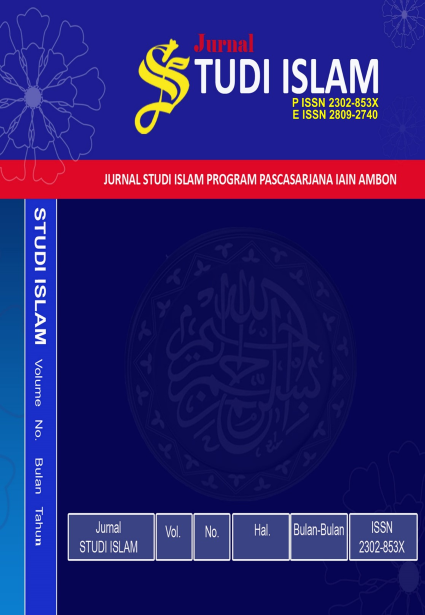EXPLORING THE DEVELOPMENT OF NEUROSCIENCE IN THE LIGHT OF ISLAMIC PERSPECTIVES: A QUALITATIVE LITERATURE REVIEW
DOI:
https://doi.org/10.33477/jsi.v12i1.3489Keywords:
Neuroscience and Islamic Perspective, Brain and Intellect in Islam, Integrating Science and Religion, Amin Abdullah's Theory.Abstract
The study aims to investigate the correlation between neuroscience and Islamic principles, addressing the notion that neuroscience is not considered an Islamic discipline due to its emergence after the revelation of the Qur'an and Sunnah in the 7th century. Utilizing a literature review approach, the researcher collected data from scientific online publications and academic sources available on Google Scholar, incorporating both scientific and religious perspectives. The research employs the theory of Prof. Amen Abdullah, which combines the values of science and religion to analyze the data through content analysis techniques. The findings of this research reveal the significant role of the fontanel (Frontal Lobe) located within the human brain, serving as a crucial center for transmitting nerve cell impulses to other sensory organs. This communication is facilitated through neurotransmitters, acting as a crucial communication center between nerve cells. Consequently, the frontal lobe plays a pivotal role in human intelligence and personality, empowering individuals to utilize their minds in enhancing the quality of their thinking. The implications of this research underscore the potential of human beings as intelligent entities, aligning science and religion in the development of Islamic studies and education. Researchers are encouraged to enrich their findings by collaborating with neuroscience experts to ensure a comprehensive interpretation of the Qur'an that resonates with contemporary scientific discoveries.
References
Abdullah, M. A. (2020). Mendialogkan Nalar Agama dan Sains Modern di Tengah Pandemi Covid-19. Maarif, 15(1), 11–39. https://doi.org/10.47651/mrf.v15i1.75
Ahmat Miftakul Huda, & Suyadi. (2020). Otak dan Akal dalam Kajian Al-Quran dan Neurosains. Jurnal Pendidikan Islam Indonesia, 5(1), 67–79. https://doi.org/10.35316/jpii.v5i1.242
Anggito, A. dan J. S. (2018). Metodologi Penelitian Kualitatif. CV. Jejak.
Aprilia Dewi Ardiyanti. (2020). Perspektif Al- Qur ’ an tentang Sel Saraf dalam Kajian Integrasi Agama dan Sains. Sains Studi Alqur’an, 2, 61–63.
Arikunto, S. (2013). Metodologi Penelitian Pendidikan: Teknik Pengumpulan Data Model Moleong. In Bumi Aksara.
Astuti Budi Handayani, S. (2019). Relevansi Konsep Akal Bertingkat Ibnu Sina Dalam Pendidikan Islam di Era Milenial. TADIBUNA, 8(2), 222–240. https://doi.org/10.32832/tadibuna.v8i2.2034
Batubara, H. H., & Supena, A. (2018). Educational Neuroscience Dalam Pendidikan Dasar. Jurnal Pendidikan Dasar, 9(2), 140–148. https://doi.org/doi.org/10.21009/JPD.092.013 EDUCATIONAL
Davis, T., LaCour, M., Beyer, E., Finck, J. L., & Miller, M. F. (2020). Neural correlates of attitudes and risk perception for food technology topics. Food Quality and Preference, 80(45), 103836. https://doi.org/https://doi.org/10.1016/j.foodqual.2019.103836
Fu’ad Arif Noor. (2018). Otak dan Akal dalam Ayat-Ayat Neurosains. Manarul Qur’an, 18(1), 115–140.
Haitomi, F. (2019). Menimbang Hermeneutika Sebagai Mitra Tafsir. NUN: Jurnal Studi Alqur’an Dan Tafsir Di Nusantara, 5(2), 45–69.
Herliani Dwi Putri Halim, N. I. (2013). Efek Neuroprotektif Ekstrak Akar Acalypha indica 500 mg/kgBB terhadap Perubahan Inti Sel Saraf Hipokampus Pascahipoksia Serebri. Efek Neuroprotektif, 1.
Iip Farliha. (2019). Tafsir Salman ITB. Bandung. In TAFSIR SALMAN ITB (p. 2010). itb.
Izzati, H. (2021). Potensi Pembelajaran Manusia : Perspektif Neurosains Dan Islam. JOURNAL OF ALIFBATA: Journal of Basic Education (JBE), 1(1), 64–77. https://doi.org/10.51700/alifbata.v1i1.89
Kamilah, J. C. (2019). Metodologi penafsiran kitab Tafsir Salman tafsir ilmiah atas Juz’Amma karya 26 Pakar ITB. UIN Sunan Ampel Surabaya.
Kasno. (2019). Aql dan Otak dalam Kajian Neurosains dan Implikasinya Pendekatan Saintifik dalam Pendidikan Islam. Muaddib: Studi Kependidikan Dan Keislaman, 09(02), 154–177.
Kusmana. (2019). THE QUR’AN, WOMAN, AND NATIONALISM IN INDONESIA Ulama Perempuan’s Moral Movement. Al-Jami’ah, 57(1), 83–116. https://doi.org/10.14421/ajis.2019.571.83-116
Moleong, lexy J. (2014). Metodologi Penelitian Kualitatif (Edisi Revi). PT Remaja Rosdakarya.
Muji, M. P. I., & Hidayatullah, D. S. (n.d.). Faundamental Taksonomi Bloom dalam Sistem Pendidikan Menurut QS Al-’Alaq ayat 1-5 (Telaah Tafsir Ibnu Katsir, Al-Qurthubi, Dan Salman).
MZ, R. D. R. (2020). Pengembangan Materi Allah Pencipta Alam Semesta Pada Pembelajaran PAI dengan Eksperimen Sains di SD Muhammadiyah Bayen. AL-MURABBI: Jurnal Studi Kependidikan Dan Keislaman, 6(2), 200–206. https://doi.org/10.53627/jam.v6i2.3681
Nurpratiwi, S., Effendi, M. R., & Amaliyah, A. (2021). Improving Religious Literacy Through Islamic Religious Education Course Based On The Flipped Classroom. Istawa : Jurnal Pendidikan Islam, 6(1), 16. https://doi.org/10.24269/ijpi.v6i1.3107
Rus’an, R. (2013). Spiritual Quotient (Sq): the Ultimate Intelligence. Lentera Pendidikan : Jurnal Ilmu Tarbiyah Dan Keguruan, 16(1), 91–100. https://doi.org/10.24252/lp.2013v16n1a8
Saibah, & Suyadi. (2020). Constructivism Of Neurosains-Based in Building The Qur’ani Character Of SMP Muhammadiyah 1 Sleman Students. Edukasi, 8(1), 85–95.
Smothers, J., Bing, M. N., White, D., Trocchia, P. J., & Absher, K. (2011). From the follower’s viewpoint: A configurational approach to the ideal academic leader. Journal of Leadership and Organizational Studies, 18(3), 293–307. https://doi.org/10.1177/1548051811404420
Solong, N. P., Munirah, M., & Arif, M. (2020). Effective School Management At Man Insan Cendekia Gorontalo. Lentera Pendidikan : Jurnal Ilmu Tarbiyah Dan Keguruan, 23(1), 22. https://doi.org/10.24252/lp.2020v23n1i3
Steffens, N. K., Schuh, S. C., Haslam, S. A., Pérez, A., & van Dick, R. (2015). “Of the group” and “for the group”: How followership is shaped by leaders’ prototypicality and group identification. European Journal of Social Psychology, 45(2), 180–190. https://doi.org/10.1002/ejsp.2088
Sutomo, I., & Budihardjo. (2021). The rejection of religious nationalism towards the secular state and the Islamic caliphate: Indonesian religious figures perspective. Indonesian Journal of Islam and Muslim Societies, 11(1), 115–137. https://doi.org/10.18326/IJIMS.V11I1.115-137
Suyadi. (2019). Hybridization of Islamic Education and Neuroscience: Transdisciplinary Studies of ’Aql in the Quran and the Brain in Neuroscience. Dinamika Ilmu, 19(2), 237–249. https://doi.org/doi: http://doi.org/10.21093/di.v19i2.1601
Suyadi, Nuryana, Z., & Asmorojati, A. W. (2021). The insertion of anti-corruption education into Islamic education learning based on neuroscience. International Journal of Evaluation and Research in Education, 10(4), 1417–1425. https://doi.org/10.11591/IJERE.V10I4.21881
Suyadi, Nuryana, Z., & Fauzi, N. A. F. (2020). The fiqh of disaster: The mitigation of Covid-19 in the perspective of Islamic education-neuroscience. International Journal of Disaster Risk Reduction, 51(2), 1–15. https://doi.org/doi.org/10/1016/J.ijdrr.2020.101848
Suyadi, Nuryana, Z., Sutrisno, & Baidi. (2022a). Academic reform and sustainability of Islamic higher education in Indonesia. International Journal of Educational Development, 89, 102534. https://doi.org/10.1016/j.ijedudev.2021.102534
Suyadi, Nuryana, Z., Sutrisno, & Baidi. (2022b). Academic reform and sustainability of Islamic higher education in Indonesia. International Journal of Educational Development, 89, 102534. https://doi.org/10.1016/j.ijedudev.2021.102534
Suyadi, S., Nuryana, Z., & Sutrisno, S. (2021). The religion in higher education curriculum referring to Indonesian qualification framework: The inclusion of neuroscience and anti-corruption education. International Journal of Education and Learning, 3(1), 38–44. https://doi.org/10.31763/ijele.v3i1.93
Taufiq, M. I. (2006). Dalil anfus al-Qur’an dan embriologi:(ayat-ayat tentang penciptaan manusia). Tiga Serangkai.
Taufiq Pasiak. (2009). Unlimited Potency of the Brain, Kenali dan Manfaatkan Sepenuhnya Potensi Otak Anda yang tak Terbatas. Mizan.
Vogel, S. E., Goffin, C., & Ansari, D. (2015). Developmental specialization of the left parietal cortex for the semantic representation of Arabic numerals: An fMR-adaptation study. Developmental Cognitive Neuroscience, 12(1), 61–73. https://doi.org/10.1016/j.dcn.2014.12.001
Waharjani, W. (2020). CHILDREN’S FAITH EDUCATION IN AN INTERFAITH MARRIAGE FAMILY (A Case Study of Moslem and Catholic Couples in the Special Region of Yogyakarta). INTERNATIONAL SEMINAR ON EDUCATION, 679–691.









